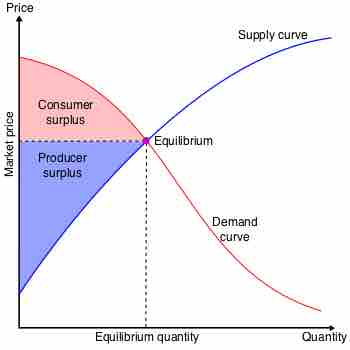Consumer surplus is the difference between the maximum price a consumer is willing to pay and the actual price they do pay. If a consumer would be willing to pay more than the current asking price, then they are getting more benefit from the purchased product than they spent to buy it. Consumer surplus plus producer surplus equals the total economic surplus in the market.
This chart graphically illustrates consumer surplus in a market without any monopolies, binding price controls, or any other inefficiencies . The price in this chart is set at the pareto optimal. This means that the price could not be increased or decreased without one of the parties being made worse off. The consumer surplus, as marked in red, is bound by the y-axis on the left, the demand curve on the right, and a horizontal line where y equals the equilibrium price. This area represent the amount of goods consumers would have been willing to purchase at a price higher than the pareto optimal price. Generally, the lower the price, the greater the consumer surplus.

Consumer Surplus
Consumer surplus, as shown highlighted in red, represents the benefit consumers get for purchasing goods at a price lower than the maximum they are willing to pay.
Another way to define consumer surplus in less quantitative terms is as a measure of a consumer's well-being. Some goods, like water, are valuable to everyone because it is a necessity for survival. But the utility, or "usefulness," of most goods vary depending on a person's individual preferences. Since the utility a person gets from a good defines her demand for it, utility also defines the consumer surplus an individual might get from purchasing that item. If a person has no use for a good, there is no consumer's surplus for that person in purchasing the good no matter the price. However, if a person finds a good incredibly useful, consumer surplus will be significant even if the price is high. An individual's customer surplus for a product is based on the individual's utility of that product.